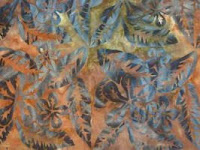A Musical Archipelago of Indonesia
The course of 20th-century European art music was influenced by the gamelan , as Impressionists like Debussy appropriated the ``strange'' five- and seven-note gamelan scales to expand the boundaries of the Western harmonic language.
In the past decade there has been a remarkable surge of American and European interest in gamelan performance; these days one need not buy a ticket to Indonesia to attend a live concert, as many major universities have their own ensembles.
Despite its high profile across the world, the gamelan is not representative of the whole of Indonesian music. This should not be surprising if you are familiar with the vast geographic extent and ethnic diversity of this archipelago, which is sometimes called a maritime continent.
With 13,600 islands and 360 ethnic groups stretched across three time zones, Indonesia has the world's largest Muslim population and is the fourth most populous overall. The many incursions of foreign influence--Hinduism and Buddhism from the 3rd to 14th century, Islam from the 11th to 15th century, Portuguese in the 16th century, Dutch from the 17th century to World War II, and short-term occupations by the British and Japanese--have all left musical legacies that are discernible in today's vast spectrum of folk and popular music. Here we discuss three major genres of pop music that have transcended regionalism to become common across the islands : kroncong , dangdut , and jaipongan.
Keroncong music sometimes mixed with other instruments & beats. The compursari music : combining Kroncong & gamelan music instruments innovated by a senior artist , MR, MANTHOUS of Gunung Kidul, Yogyakarta, is now very popular.
The Kroncong songs are also sometimes played with REGGAE or DANGDUT beat.
Three major street-popular idioms. Kroncong, a seductive music for fiddle, ukulele and guitar, probably originated under Portuguese influence back in the 17th century. Dangdut is a newer, percussion-based style with strong Muslim influences. Langgan Jawa is a form of kroncong with strong links to other local styles. Also included is some village ronggeng and a guitar-backed style that crosses local, Latin and Indian influences. These 1970s street performances, by market and other itinerant musicians are earthier and, I find, much more interesting than their studio equivalents.
The one singer most responsible for the rise of dangdut in the last two decades is Rhoma Irama, a working-class hero whose songs manage to combine Islamic piety, social criticism, and family values, while simultaneously glamorizing his rags-to-riches tale. Dangdut has also become part of Indonesian cinema, and Irama's 1980 film, Perjuangan dan Do'a (``Struggle and Prayer'') may well have been the first Islamic rock film ever made.
Women have also made their mark in dangdut. Elvy Sukaesih, who purveys a more indigenous style, is the reigning queen, while Detty Kurnia is making headway overseas in the lucrative Japanese market. And Inul Daratista, the "goyang ngebor" woman. She always dance with her bottom. So sexy :D
Emerging from Sunda (West Java) in the 1970s, jaipongan has rapidly spread to other parts of Indonesia, riding the wave of a dance craze that can be arguably traced back to a decree by President Sukarno in the early Sixties that banned all ``foreign'' music including rock n' roll. Young musicians who had been happily playing the twist and jive for eager audiences were forced to invent purely indigenous replacements.
One enterprising student named Gugum Gumbira Tirasondjaja embarked on a study of rural dance and festival music that occupied him for twelve years. By far his most popular experiment proved to be the updating of a village ritual music called ketuk tilu , which is the name of a pot-gong used in the ensemble. The rest of the group typically consists of other gongs, a rebab (spike fiddle), barrel drums, and a female singer-dancer, ronggeng , who is often also a prostitute. Gugum's contribution was in expanding and energizing the drum section, redefining the singer as just a singer, and giving the music a catchy onomatopoeic name.
In jaipongan the gongs are tuned to a pentatonic scale, while the melody carried by the rebab and the vocalist are usually in a heptatonic scale. The subtle dissonance between the two scales comes and goes as microtonal inflections in the melody play on this effect. Within a song, the texture alternates between sections in which the singer lyrically unfurls tales of love, money, and agriculture over a stately gong cycle, and passages of frenetic drumming, whooping, and grunts by the rest of the band. It was hard to miss the irony when the authorities tried to crack down on jaipongan , offended by the ``overly sensuous'' nature of the dancing, which was based on an authentically traditional form--the government got what they asked for.
The official ban on foreign pop music lasted only a few years, and today's bands are free to play anything from reggae to heavy metal to covers of John Denver. It is a tribute to the vitality of the local musical traditions that modern Indonesian pop has not been completely dominated by such foreign forms, as has happened in neighboring countries like Malaysia and the Philippines. It's about time that the rest of the world discovered the flourishing Indonesian music scene beyond the gamelan .







